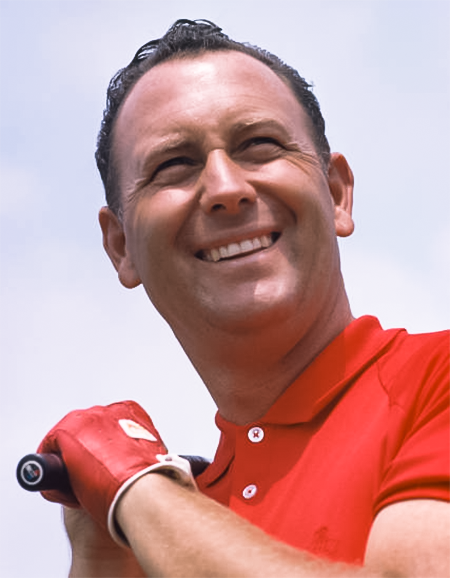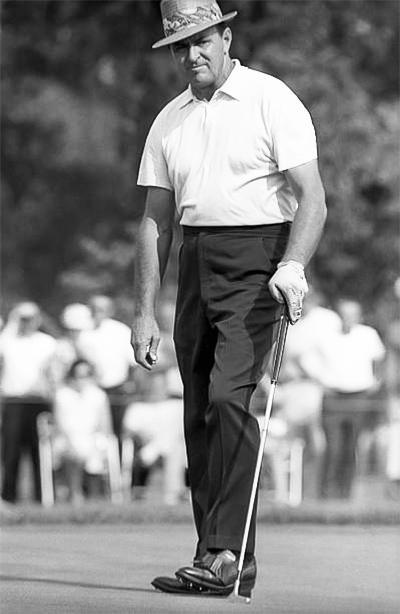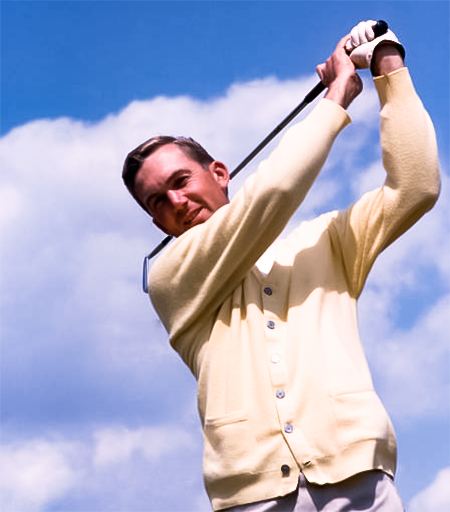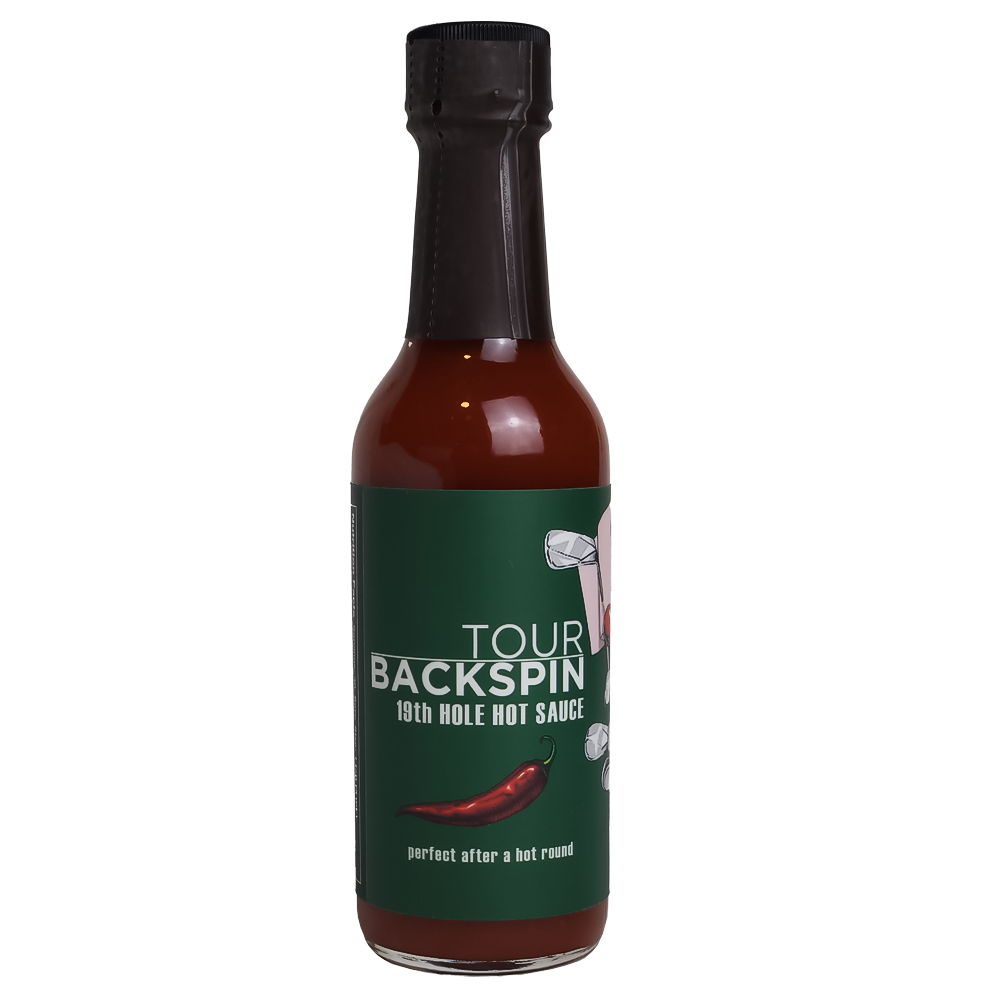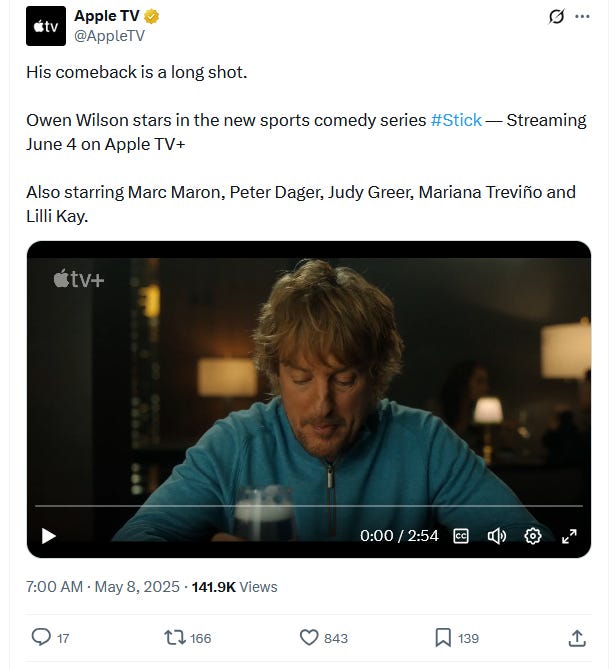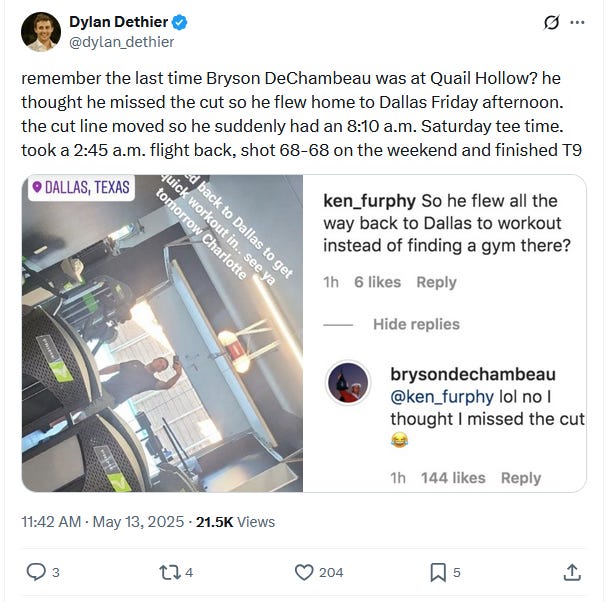Tragedy at PGA Championship
The celebration of Al Geiberger capturing the 1966 PGA Championship ends with tragic news.
Join us, and over 850 golf sickos who subscribe to Tour Backspin, on our journey through the past as we transport back to 1966 and the PGA Championship at Firestone Country Club in Akron, OH. This major championship week had everything as it featured a very popular champion with his own unique story, a challenging golf course, and an ending that would rank as the most tragic news for the PGA TOUR in the decade of the 1960s. Scroll down to go inside the ropes that week in July of 1966.
The PGA TOUR featured a Signature Event last week, just one week before the second major of the year. What was cool about it was that the golf course was almost as much of a viewer attraction as the the play on that course. Scroll down for my take on the week in the PGA TOUR Wrap-Up, and check out the Clips I Loved.
PAST TOUR BACKSPIN ARTICLES AND PODCASTS ON THE PGA CHAMPIONSHIP
Dave Stockton holds off Arnold Palmer, and Arnie’s Army, to win the 1970 PGA Championship.
Listen as the Tour Backspin Show covers Dave Stockton’s win in 1970.
Welcome to the over 60 new subscribers to Tour Backspin! You’ll find an in-depth historical account on a tournament from the 1960s, ‘70s, and ‘80s, that share some DNA with the tournament currently being played on the PGA TOUR, in your email inbox every Thursday morning. If you have any ideas, or suggestions, for the newsletter, please email me at larry@tourbackspin.com.
Thank you to those of you who have upgraded to a Premium Subscription. Your support allows us to continue to grow Tour Backspin. If you have not upgraded to a Premimum Subscription, please consider doing so. At just $36 per year, you will be supporting our work and keeping this newsletter sustainable.
Enjoy the major championship week at the PGA Championship from Charlotte this week.
A major tournament always allows us to do an over/under on the final score. What do you like? The over or the under? Let us know in this week’s The Tour Backspin Poll. This week’s Vintage Ad from 1966 (below the paywall) stars Tony Lema selling his line of golf clothing. Scroll down to view.
We’ve got some great content coming up on The Tour Backspin Show YouTube channel. Subcribe, for free, to make sure you don’t miss a thing.
The Tour Backspin Poll
In last week’s Tour Backspin Poll we asked “who ya got?” in the PGA Championship. There were 63% of respondents who think that Scottie Scheffler will capture the Wannamaker Trophy, while an equal number of respondents, at 13%, figure that Rory McIlroy, Bryson DeChambeau, or Ludvig Åberg will take home the title.
Do you think the winning score will be over 270.5 (-13.5). Will the early week wet weather lead to low scores? Over/Under figure provided by GolfOdds.com. Let us know in this week’s Tour Backspin Poll.

We’re playing Guess the Nickname in this week’s Tour Backspin Quiz. Scroll down to take the challenge. Give us your best guess in this week’s WHAT HOLE IS IT? and if you get it correct you may win prizes from the Tour Backspin Golf Shop.
Did you miss a previous newsletter? You can view it HERE. Help us grow Tour Backspin! Please forward this email to a friend. Was this newsletter forwarded to you? You can sign up HERE.
Okay, we're on the tee, let's get going.
Enjoy!
Larry Baush
Al Geiberger Wins PGA Title at Firestone
It’s mid-afternoon on Sunday, July 24th, 1966. Tony Lema had just finished his final round at Firestone Country Club in the PGA Championship. He was headed back out to the course, up the 18th fairway, where his friend, Butch Baird, was finishing his final round. Lema had something important to tell Baird. Something that would change Baird’s life forever.
Robert Trent Jones redesigned the South Course at Firestone in 1959, and the PGA granted the course the 1960 PGA Championship even before the work had begun. Jones added over 50 bunkers, two ponds, built two new greens and completely remodeled the other 16 greens enlarging them and building in new contours providing more pin position options. The only thing remaining of the original design was the fairway routing. The redesigned course measured 7,180 yards, which was more than 400 yards longer than the original course. Plus, the par was reduced from 72 to 70.
Trent was proud of his remodel while some of the pros were less than thrilled with the new layout. Scores in the 1960 PGA were high with just six rounds under par in the first two rounds and only seven during the weekend.
When Columbine Country Club, outside of Denver, the original site for the 1966 PGA Championship, was damaged by flooding, the tournament was moved to Firestone. The fact that Firestone was quite accustomed to hosting PGA TOUR events made it a natural choice.
On July 8th of 1966 the AFL-CIO International Association of Machinists walked out on strike against five airline companies, Trans World Airlines (TWA), Eastern Airlines, National Airlines, Northwest Airlines, and United Airlines, the largest airlines serving the country.
This strike lasted until August 19th and caused havoc for the PGA TOUR players making their way to Akron for the PGA Championship. Both Arnold Palmer and Jack Nicklaus coped with the travel hassles by flying in their own planes. Arnie was at the controls of his new Jet Commander. The two commuted each day to the course from their homes, Palmer from Latrobe, PA, Nicklaus from Columbus, OH.
They both loved buzzing the course at low altitude as they left Akron.
Pre-tournament favorites included the money list leader, Doug Sanders, who pocketed $86,311 to this point in the year, Arnold Palmer, currently second on the money list with $84,652 and looking for the last title he needed to complete a career Grand Slam, and Billy Casper, third on the money list with $78,260.
Palmer described the 16th as “the worst” and a hole he “frankly hated.”
Gay Brewer, and Tony Lema were also favored. Lema told the UPI that he liked his chances “because I play this course well”. For his part, Nicklaus felt confident, so confident that he planned to pass up a practice round on Tuesday instead getting some rest. This was very un-Nicklaus-like. He was listed as a 4-1 favorite, while Palmer was listed at 6-1.
Of all the players in the field, Palmer had the best scoring average at Firestone. In the six tournaments he’d played at Firestone he had averaged 70.3 strokes. That didn’t mean he loved the course, though. He was a critic of the 16th hole at Firestone. It was here that Palmer shot himself out of the 1960 PGA Championship, with an eight and finished in a tie for seventh. Palmer described the 16th as “the worst” and a hole he “frankly hated.”
Tony Lema did a preview for the newspapers and picked Casper as his favorite saying, “Billy is playing marvelously, and I think he’s a mighty good bet.” Casper was listed at 10-1 odds by Golf Digest.
Casper liked his own chances—if the conditions were right. The analytical Casper felt he needed the wind to blow more than 8 miles per hour and from the southeast. This would blow the fumes from the rubber plants away from Firestone and would relieve Casper of the stuffy nose, headaches, and irritated lungs that he’d previously experienced at Firestone when he played in the American Golf Classic.
An article by Dave Burgan for the NEA syndicate reported on Casper and his complaints about playing in Akron. He reported that Casper gave tournament organizers a list of what he would need that week in Akron. The list included a house due south of town that was air-conditioned and had an electric cooking range. He claimed that he was allergic to the chemical reactions of gas cooking. He also listed his special dietary needs including buffalo meat and whale steaks.
Pre-tournament coverage included an AP story under the headline “Sam Snead Not Conceding” and had Snead saying, “I could win another one if I could get the ‘ifs’ out of my putting.” He was also plagued with soreness in his hip that week that caused him to limp.
The fact that Al Geiberger had a good track record at Firestone meant little to the “experts” when they made their predictions as he was listed at 10-1 odds. Geiberger won the 1965 American Golf Classic, played at Firestone, by four strokes over Arnold Palmer with a four-round total of 280, four-under-par.
The setup at Firestone by the PGA of America was different than the setup for the 1960 PGA Championship, or the 1964 American Golf Classic. Ken Venturi complained that the rough was not as thick as it was when he won the 1964 American Golf Classic at Firestone. “There might as well not be any rough on this course at all,” he said. Jack Tuthill, the tournament supervisor, acknowledged that the once-nasty rough had been cut down. It measured about two inches in the first cut and graduated deeper the further into it you went. A seeding process had changed the greens to pure bent grass, the hardest greens to read.
Firestone was further changed by nature starting in 1961 with the onset of Dutch Elm Disease, a disease that is spread by bark beetles and attacks the tree by starving it of water and nutrients eventually killing it. By 1966 Firestone had several trees wiped out.
Still, in 1966, Firestone presented one of the tougher challenges that PGA TOUR pros encountered.
The weather for the first round was almost perfect; temperatures were moderate, in the 70s, and there was just a light wind. Leo H. Petersen, UPI Sports Editor described Firestone as “sunbaked and rugged.” And even with a light wind, Billy Casper told reporters that he had to hustle back to his private home lodgings “to get some oxygen” because of the rubber dust in the air. He shot 73, as did Gary Player.
Don January set the pace early with a 69 after he birdied the first hole and then added 17 straight pars. He held the lead for most of the day until Julius Boros caught him and posted his own 69.
Doug Sanders surprised himself by playing well as he also shot a 69. Sanders had low expectations because he felt exhausted, and he had a blister on his right thumb. After his round he lamented that he tried to get “a little too fancy” on the 18th hole which led to a double bogey.
The 54-year-old Sam Snead was successful in the first round getting the ‘ifs’ out of his putting. He putted magnificently as he shot a 34-34-68 with five birdies and three bogeys.
Al Geiberger matched Snead’s 68 with a round that included four birdies offset by two bogeys. Al credited his famous peanut butter and jelly sandwiches for his good round.
“After the 13th hole, I had a sandwich and then I birdied 14 and played pretty well the rest of the day,” he told reporters after his round.
The reporters had fun with the sandwich angle. One reporter asked him why he didn’t have a peanut butter company to sponsor him the way that Tony Lema, famous for treating the press corps to champagne after every tour win, had Monet Champagne as a sponsor. Geiberger admitted that his manager was working on a deal, but he surmised that “It wouldn’t be that popular,” at least compared to Lema’s champagne. Then another reporter suggested that his fans could have a name like Arnie’s Army. The reporter’s suggestion? Geiberger’s Goobers. Little did the reporter know that Al and his manger were working on “Al’s Pals” as a name for his fans.
The co-leaders and the three players at 69 were the only players in the 163-player field that managed to break par. Jacky Cupit matched par shooting a 70. Big name players who struggled in the first round included Jack Nicklaus, Arnold Palmer and defending champion, Dave Marr who all shot 75. Bobby Nichols, the 1964 PGA Champion, shot a 76 and Tony Lema soared to 78.
“I don’t think that anyone in the field is going to break par for four rounds.”
The weather for the second round continued to be almost perfect and the course continued to play hard and fast. Sam Snead recorded a one-over-par 71 although he had to work very hard for that score. He recovered from five bunkers to save par. He had three bogeys, two of those on par threes and the other one on the par four, 450-yard 3rd hole when his approach shot missed the green. Snead complained to reporters after his round that the “par threes really gave me fits.”
Al Geiberger and Don January made a run at Snead but came up one shot short. Geiberger shot a two-over 72 with an erratic round that included five birdies, five bogeys and a double bogey. January shot a one-over 71.
After his round, January said, “I don’t think that anyone in the field is going to break par for four rounds.”
So far, Snead was the only player under par with a two-round total of 139. Juluis Borus was one stroke behind Geiberger and January at 141 while Gary Player, Billy Casper, Doug Sanders, Billy Farrell and Jacky Cupit were all bunched up at 143. Only four players were able to match Firestone’s tough par 70 in Friday’s second round.
The weather continued to be sublime for Saturday’s third round with temperatures in the 80s and mostly sunny skies. Al Geiberger got his round off to a good start by birdieing the 500-yard, par-5, 2nd hole and that put him in a tie with Snead for the lead. Geiberger took sole possession of the lead after Snead three-putted the 465-yard, par-4, 6th hole for a bogey, the first of three bogeys. He missed his second putt on the 6th hole from 20-inches.
His putting, which had been so good up to this point in the tournament, deserted him and after inadvertently tapping his putt on the 10th hole, he unveiled a croquet-style stroke with his right hand placed down near the hosel of his putter. He used this stance for the remainder of the tournament. It was the first time that Snead used the putting style, one that the USGA eventually banned forcing Snead to convert to a sidesaddle stance where he could still “push” the ball towards the cup.
“From then on, with his iron play, I knew this cat was going to win.”
Geiberger found five of the many bunkers at Firestone and was able to get up-and-down each time—once for a birdie and the other four times for pars. The press continued to focus on the peanut butter and jelly sandwiches that Geiberger ate on the course. It was reported that he ate one half on the seventh hole and the other half on the 11th hole.
According to his 18-year-old caddie, Mick Gannon, the turning point of the round came at the 14th hole where Al made birdie. “From then on, with his iron play, I knew this cat was going to win.”
Geiberger felt confident about his chances for winning.
“I shoot well on this course,” he told reporters. “Because it forces you to hit better. You can’t hold back or try to steer your shots. You have to go out and hit them and as a result, you make better shots.”
Geiberger was being challenged by a streaking Dudley Wysong playing in his first PGA Championship. He toured the sun scorched course in 66 strokes, the low round of the tournament and moved into second place, four strokes off the lead.
Other notable scores in the third round included Gary Player who shot a 70 and sat at 213, five strokes off Geiberger’s lead. Don January added a 73 putting him into a tie with Player. Frank Beard got into the mix with a fine 69 and a three-round total of 214 tied with Snead and Ferrell. Despite his constant need for oxygen, Billy Casper was at a respectable 216 tied with Doug Sanders, Julius Boros, and Jacky Cupit.
Sunday dawned warm with sunny skies and as the leaders teed off in the final round, a slight breeze blew. Geiberger’s start to his round was not as calm as the weather. He bogeyed the first two holes. So did Dudley Wysong. Wysong bounced back with a birdie at the third hole and when Geiberger added another bogey on the fourth hole, the lead was down to two.
“That one charged me.”
The poor start, and his lead shrinking, did not seem, on the surface, to get Al too concerned. He whistled a little ditty as he walked from the 4th green to the 5th tee. However, after the round, he admitted that “I was thinking about the title and all it would do for me. It almost wrecked me.”
At the par-3, 230-yard 5th hole, Al stepped up and hit his tee shot to 20 feet. He then calmly stroked the putt into the hole for a birdie that restored his confidence.
“That one charged me,” Al said after his round.
With the birdie, Al’s lead was back to four and nobody was mounting a charge. Arnie did shoot his lowest score of the tournament with a 68 on Sunday, but it was too little, too late.
“My main goal was to get past the 16th hole.”
Al played steady golf on the back nine and seemed relaxed. When a 40-foot putt lipped out he flashed a smile and simply said, “shucks”. After he hit the fairway at the 14th hole, the crowd mildly applauded, but when he reached into his bag and retrieved his peanut butter and jelly sandwich and began eating it, the crowd erupted with a roar. Despite the snack, he stumbled with a bogey at the 15th. And then, he was at the 16th at Firestone, the hole that did in Palmer in 1960. Al had been preparing himself for the tough hole.
“My main goal,” Al told reporters after his round, “was to get past the 16th hole. When I did that in par, I figured I had it.”
And he did. At the final hole, Al made a big show of lining up his final putt, a six-incher, to the crowd’s delight. He won by four strokes, with an even par score of 280, the same score he shot at Firestone in the 1965 American Golf Classic. Wysong finished second, four strokes behind while Billy Casper, despite his troubles with the air quality, finished in a tie with Gene Littler and Gary Player at 286. Palmer was another stroke back, tied with Julius Boros, Doug Sanders, Jacky Cupit, and Sam Snead.
“Peanut butter and jelly sandwiches for all!”
Geiberger won $25,000 and would be coming back to Firestone, now his favorite course, to play in the lucrative World Series of Golf where he was guaranteed at least $5,000 and had a shot to win $50,000.
Al thoroughly enjoyed himself during the post round festivities. His interview on national television was interrupted by the roar of a plane overhead, and he looked up at it in the sky and then said, “Bye bye, Arnie” and the crowd laughed. As he arrived to meet the press, he shouted out, “Peanut butter and jelly sandwiches for all!” He then took his seat in the press tent and was presented with a three-pound jar of peanut butter and a loaf of bread.
Then the assembled press pummeled him with questions about the peanut butter. One reporter asked, “Why peanut butter and jelly?” Al responded, “Did you ever carry a tuna fish sandwich in your bag and forget to eat it? My bag would smell like a garbage can.”
Once he was done with the press, Al, and his wife Judy, went back to the rental house where they were staying along with some friends. The national television broadcast of the tournament in those days blacked out the live broadcast within a certain radius near the venue. They would then re-broadcast it later, and the group at Al’s rental house tuned in. The group was in a celebratory and jovial mood until a breaking news alert broke into the broadcast with the news that Tony Lema, and his wife Betty, were killed in a small plane crash. The news shocked the group at the rental house and reverberated across the golf world.
“I didn’t know how to act.” Geiberger told Tour Backspin in a phone call.
That conversation between Tony Lema and Butch Baird earlier in the day on the 18th fairway changed Baird’s life because he was scheduled to join Tony and his wife Betty on that ill-fated flight. A change in the size of the chartered aircraft, to a smaller plane, necessitated a change in Baird joining the flight. Check out the Bonus Story (behind the paywall) for more on how that Sunday evening played out.
Coming Next Week: Lanny Wadkins comes from five strokes off the lead to win the 1988 Colonial National Invitational
Tour Backspin is a reader-supported publication. To receive premium content including early release of The Tour Backspin Show, please consider upgrading to a premium subscription for just $36 per year. Premium subscribers help fund the research I do, and in return, they get exclusive access to special articles and early access to our YouTube channel.
WHAT HOLE IS IT?
I hate it when I do this. I pick a hole being used from the course hosting the PGA TOUR without researching the course setup. If the course setup has been changed, it usually is a flipping of the front and back nines for the tournament leading to different “correct” answers. At the Truist Championship, Philadelphia Cricket Club was configured with a total mashup of the hole sequencing—also leading to multiple “correct” answers. It also required me to figure it out.
When this happens, I credit players with the correct answer whether they identify the everyday hole, or the tournament hole. This meant that answers of #3 or #14 were credited as correct answers this week. Congratulations to Al Oppenheim, the winner last week. He beat seven other correct answers in the random drawing. We’re adding more to the gift discount code to The Tour Backspin Golf Shop to Al’s total as he is a multiple winner. We are sending discount codes to the winners of WHAT HOLE IS IT? in 2025 so that they can choose their prize from the offerings in The Tour Backspin Golf Shop, including the Tour Backspin 19th Hole Hot Sauce. Winners can combine multiple discount codes to use on a single order, and the codes never expire. When the code is redeemed, the prize will be sent with free shipping, so getting your prize will not cost you anything. Check out The Tour Backspin Golf Shop HERE.
We understand if a premium subscription isn’t in the budget, and we’re happy to have you here however you’ve arrived. You can sign up for a free subscription so you’ll never miss the newsletter. It will arrive in your inbox every Thursday. Paid subscribers help fund the work we do here at Tour Backspin.
I’ve just returned from another editing session on the Tony Lema documentary. We’re making a lot of progress, but it’s a slow process. Here’s some more of the film that we had cleaned up and digitized for the movie. Tony talks to Howard Cosell about the individual aspect of golf. (clicking on link will open this post on the web, scroll down to video player).
Click on image to view on the web.
You can now support the induction of Tony Lema into the World Golf Hall of Fame. Sign the online petition HERE.
Tour Backspin Quiz | Guess The Nickname
Pictured below are nine golfers from the Tour Backspin era. Do you know their nicknames?
Scroll down for answer
Clips I Loved
Can’t wait for this.
Sepp Straka after winning the Truist Championship.
Good caddie conversation here.
Bryson being Bryson.
Are you surprised how long this took?
Know the rules. You can use them to your advantage sometimes.
Remember the USFL, the last “league” Trump got involved in?
PGA TOUR Wrap-Up | Truist Championship
With the PGA Championship being played this week, at the Quail Hollow Club in Charlotte, NC, the usual host of the Truist Championship, the tournament was moved to the historic Philadelphia Cricket Club. The spotlight on the course renewed positive vibes for the “golden age of golf course architecture” and it was fun to see today’s touring pros play the course.
Sepp Straka and Shane Lowry started the final round tied at 14-under, and Straka played the A.W. Tillinghast design very calmly. His steady play payed off on the 16th hole where he captured the lead with a par to Lowry’s bogey. His par at the final hole gave him a two-shot victory after Lowry three-putt.
The trophy awarded to Straka was a one-off trophy because of the location change. Pretty cool to win not only a PGA TOUR title, but a one-of-a-kind piece of hardware for the trophy case.
Lowry’s three-putt at the final hole dropped him into a T2 with Justin Thomas who has really been rounding into shape going into this week’s PGA Championship. Thomas finished with a final round 67 for a total of 266 while Lowry had a final round 70. Straka finished with a 68 for a total of 264.
Read more from Jeff Smith of Pro Golf Weekly HERE.
Here are the final round highlights from the Truist Championship:
Tour Backspin is a reader-supported publication. To receive new posts and support my work, consider becoming a free or paid subscriber. We try to make as much of our content available for free subscribers as we can, but it is the paid subscribers who help make this newsletter sustainable. Please consider upgrading.
Tour Backspin Quiz Answer:
From left to right.
Top Row: Gene Littler (“Gene the Machine”), Bob Murphy (“Murph the Turf”), Donna Caponi Young (“Watusi”)
Second Row: Miller Barber (“Mr. X”), Julius Boros (“Moose”), Joanne Carner (“Big Momma”)
Bottom Row: Ben Hogan (“The Hawk”), Jack Nicklaus (“The Golden Bear”), Tony Lema (“Champagne Tony”)
What’s behind the paywall:
Bonus Story
Blind Shot
Al Geiberger talks to Tour Backspin about Firestone Country Club
My Open Tabs
Vintage Ad
Final Thoughts
Now that we’re at the turn, grab a beer and a hotdog and let’s get into the back nine.
Keep reading with a 7-day free trial
Subscribe to Tour Backspin to keep reading this post and get 7 days of free access to the full post archives.








